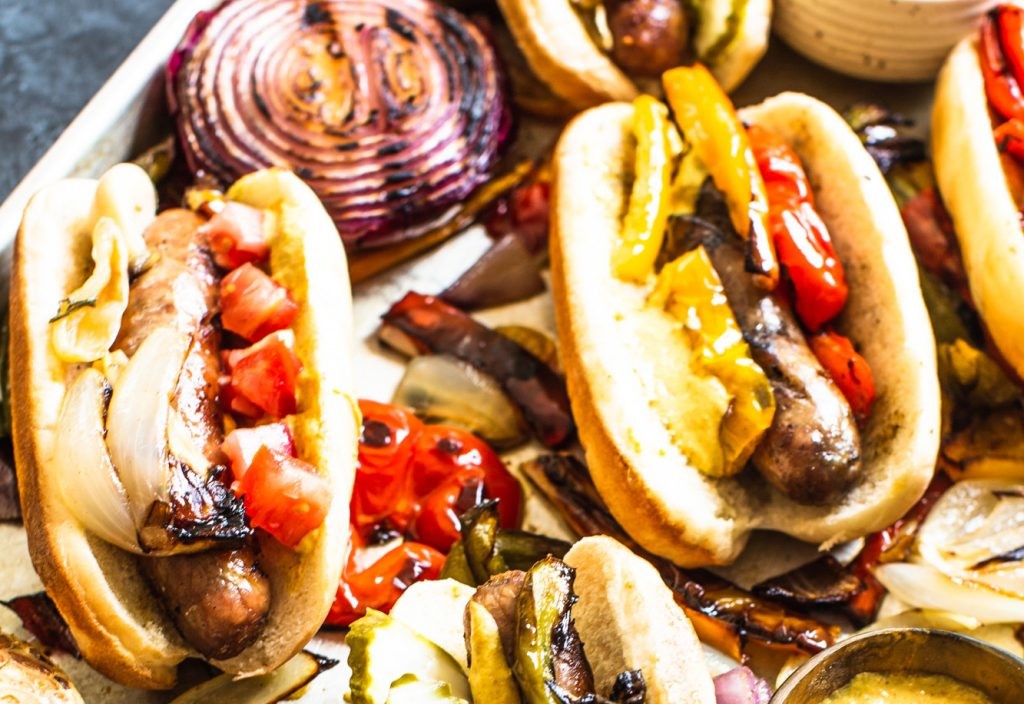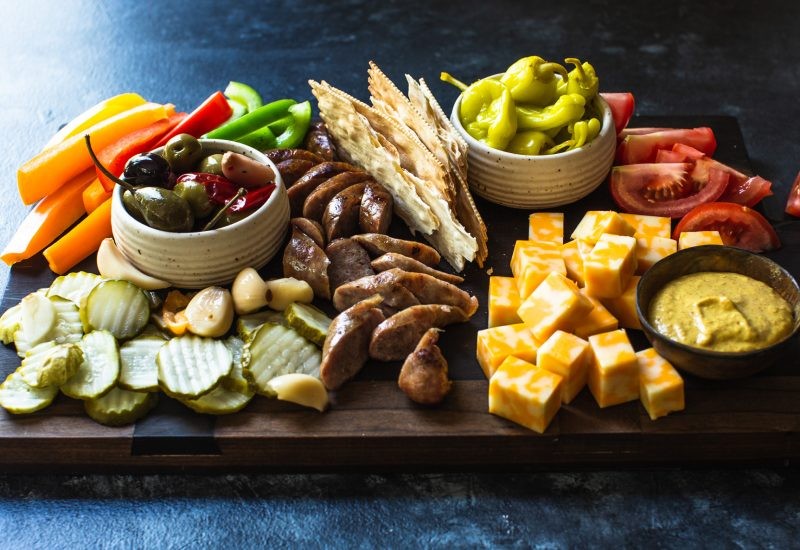What Is Bratwurst? Bratwurst, a type of German sausage, offers a delicious and savory culinary experience. If you’re eager to learn about this iconic sausage, WHAT.EDU.VN is here to provide you with the answers you need. Discover all about bratwurst, its history, how it’s made, and the best ways to enjoy it. Explore related topics like sausage varieties, grilling tips, and recipe ideas to enhance your understanding.
1. What is Bratwurst?
Bratwurst is a type of German sausage traditionally made from pork, veal, or beef. The name “bratwurst” comes from the Old High German words “brät” (finely chopped meat) and “wurst” (sausage). It’s a staple in German cuisine and is enjoyed worldwide for its distinctive flavor and versatility.
1.1. Historical Overview of Bratwurst
The history of bratwurst dates back to 1313 in Franconia, Germany. Over the centuries, various regions in Germany developed their own unique bratwurst recipes, using different combinations of meats and spices. This rich history contributes to the wide variety of bratwurst available today.
1.2. Regional Variations of Bratwurst
Here are some of the popular regional variations of bratwurst:
- Nürnberger Bratwurst: A small, thin bratwurst from Nuremberg, Germany, traditionally grilled and served in groups of six, nine, or twelve.
- Thüringer Rostbratwurst: From Thuringia, Germany, this bratwurst is longer and seasoned with marjoram, caraway, and garlic.
- Coburger Bratwurst: From Coburg, Germany, this bratwurst is made with beef and pork and grilled over pine cones, giving it a unique smoky flavor.
2. What is Bratwurst Made Of?
Bratwurst is typically made from ground pork, but can also include veal and beef. The meat is mixed with various spices, such as salt, pepper, nutmeg, and marjoram. The mixture is then stuffed into natural or synthetic casings.
2.1. Key Ingredients in Bratwurst
Here are the essential ingredients that go into making bratwurst:
- Meat: Pork is the primary ingredient, often combined with veal or beef.
- Spices: Common spices include salt, white pepper, nutmeg, lemon peel, marjoram, caraway, and garlic.
- Casings: Natural casings (made from animal intestines) or synthetic casings are used to hold the sausage mixture.
2.2. The Process of Making Bratwurst
The process of making bratwurst involves several steps:
- Grinding the Meat: The meat is ground to a fine consistency.
- Mixing Ingredients: The ground meat is mixed with spices and seasonings.
- Stuffing the Casings: The mixture is stuffed into casings using a sausage stuffer.
- Twisting or Linking: The stuffed sausages are twisted or linked to form individual bratwursts.
3. What is Bratwurst Used For?
Bratwurst is incredibly versatile and can be used in a variety of dishes. It is commonly grilled, pan-fried, or boiled. It can be served on a bun with toppings like mustard, sauerkraut, and onions, or used as an ingredient in casseroles, stews, and other recipes.
3.1. Traditional Ways to Serve Bratwurst
Here are some traditional ways to serve bratwurst:
- Grilled Bratwurst: Grilled bratwurst served on a bun with mustard and sauerkraut is a classic German street food.
- Bratwurst with Potato Salad: Bratwurst is often served with German potato salad as a side dish.
- Bratwurst with Sauerkraut: Pairing bratwurst with sauerkraut is a traditional German meal.
3.2. Creative Bratwurst Recipes
If you’re looking to get creative with bratwurst, here are some ideas:
- Bratwurst and Pepper Skewers: Grill bratwurst with bell peppers and onions for a colorful and flavorful skewer.
- Bratwurst Pizza: Top a pizza with sliced bratwurst, caramelized onions, and mustard for a unique twist.
- Bratwurst Chili: Add bratwurst to your favorite chili recipe for a hearty and savory dish.
Image of grilled bratwurst showing its texture and color.
4. What Are the Benefits of Eating Bratwurst?
Bratwurst can be a good source of protein and certain vitamins and minerals. The nutritional content can vary depending on the ingredients used, but it generally provides essential nutrients.
4.1. Nutritional Value of Bratwurst
Here is an approximate nutritional breakdown for a typical bratwurst (per serving):
- Calories: 250-350
- Protein: 15-20g
- Fat: 20-30g
- Carbohydrates: 2-5g
It’s important to note that these values can change based on the specific recipe and ingredients used.
4.2. Health Considerations When Eating Bratwurst
While bratwurst can be a part of a balanced diet, it’s essential to consider the following:
- Fat Content: Bratwurst can be high in fat, so moderation is key.
- Sodium Content: Check the sodium levels, especially if you are watching your salt intake.
- Ingredients: Choose bratwurst made with high-quality ingredients and fewer additives.
5. What Are the Different Types of Bratwurst?
There are numerous types of bratwurst, each with its unique flavor profile and ingredients. Exploring these different varieties can enhance your appreciation for this German staple.
5.1. Common Bratwurst Varieties
Here are some common types of bratwurst:
- Pork Bratwurst: Made primarily from pork, seasoned with various spices.
- Veal Bratwurst: Made from veal, offering a milder flavor.
- Beef Bratwurst: Made from beef, providing a richer taste.
- Chicken Bratwurst: A lighter alternative made from chicken.
5.2. Specialty Bratwurst Flavors
In addition to the basic types, there are also specialty bratwurst flavors:
- Beer Bratwurst: Infused with beer for a unique, malty flavor.
- Jalapeño Bratwurst: Contains jalapeño peppers for a spicy kick.
- Cheddar Bratwurst: Filled with cheddar cheese for a creamy, cheesy taste.
6. What is the Best Way to Cook Bratwurst?
There are several methods to cook bratwurst, each offering a slightly different result. Grilling, pan-frying, and boiling are the most popular methods.
6.1. Grilling Bratwurst
Grilling bratwurst gives it a smoky flavor and a crisp casing. Here are some tips for grilling bratwurst:
- Preheat the Grill: Preheat your grill to medium heat.
- Indirect Heat: Cook the bratwurst over indirect heat to prevent burning.
- Turn Regularly: Turn the bratwurst regularly to ensure even cooking.
- Use a Thermometer: Use a meat thermometer to ensure the internal temperature reaches 160°F (71°C).
6.2. Pan-Frying Bratwurst
Pan-frying bratwurst is a quick and easy method, perfect for when you don’t have access to a grill. Here’s how to pan-fry bratwurst:
- Heat a Pan: Heat a pan over medium heat with a little oil or butter.
- Cook Evenly: Cook the bratwurst, turning occasionally, until browned on all sides.
- Check Temperature: Ensure the internal temperature reaches 160°F (71°C).
6.3. Boiling Bratwurst
Boiling bratwurst is a good way to ensure it’s cooked through, but it can sometimes result in a less flavorful sausage. Here’s how to boil bratwurst:
- Boil Water: Bring a pot of water to a boil.
- Add Bratwurst: Add the bratwurst and reduce the heat to a simmer.
- Cook Thoroughly: Simmer for about 15-20 minutes, or until cooked through.
- Optional: Sear: For added flavor, sear the boiled bratwurst in a pan or on the grill after boiling.
7. What is the Best Way to Store Bratwurst?
Proper storage is essential to maintain the quality and safety of bratwurst. Here are some tips for storing bratwurst:
7.1. Refrigerating Bratwurst
- Raw Bratwurst: Store raw bratwurst in the refrigerator for 1-2 days.
- Cooked Bratwurst: Store cooked bratwurst in the refrigerator for 3-4 days.
- Proper Packaging: Ensure the bratwurst is properly wrapped or stored in an airtight container.
7.2. Freezing Bratwurst
- Freezing Raw Bratwurst: Raw bratwurst can be frozen for up to 2-3 months.
- Freezing Cooked Bratwurst: Cooked bratwurst can be frozen for up to 2 months.
- Proper Freezing: Wrap the bratwurst tightly in freezer wrap or place it in a freezer bag to prevent freezer burn.
8. What is the Difference Between Bratwurst and Other Sausages?
Bratwurst is just one type of sausage among many. Understanding the differences between bratwurst and other sausages can help you choose the right sausage for your needs.
8.1. Bratwurst vs. Kielbasa
- Bratwurst: A German sausage typically made from pork, veal, or beef, seasoned with spices like nutmeg and marjoram.
- Kielbasa: A Polish sausage usually made from pork and/or beef, often smoked and flavored with garlic and marjoram.
8.2. Bratwurst vs. Italian Sausage
- Bratwurst: A German sausage with a mild, savory flavor.
- Italian Sausage: An Italian sausage made from pork, seasoned with fennel and other Italian herbs and spices. It can be sweet, mild, or hot.
8.3. Bratwurst vs. Hot Dogs
- Bratwurst: A German sausage made from pork, veal, or beef, with a distinct flavor profile.
- Hot Dogs: An American sausage typically made from beef or pork trimmings, seasoned with a blend of spices and often smoked.
9. What Are Some Popular Bratwurst Toppings and Condiments?
The right toppings and condiments can elevate your bratwurst experience. Here are some popular choices:
9.1. Traditional Toppings
- Mustard: A classic choice, especially German mustard or spicy brown mustard.
- Sauerkraut: Fermented cabbage that adds a tangy flavor.
- Onions: Grilled or caramelized onions provide sweetness and depth.
9.2. Creative Condiments
- Beer Cheese Sauce: A creamy, cheesy sauce infused with beer.
- Pickled Peppers: Add a spicy and tangy kick.
- Relish: Sweet or dill relish for added texture and flavor.
10. What Are Some Common Mistakes to Avoid When Cooking Bratwurst?
To ensure your bratwurst turns out perfectly every time, avoid these common mistakes:
10.1. Overcooking Bratwurst
Overcooking bratwurst can result in a dry, tough sausage. Use a meat thermometer to ensure the internal temperature reaches 160°F (71°C) without overcooking.
10.2. Pricking the Bratwurst Before Cooking
Pricking the bratwurst before cooking can cause the juices to escape, resulting in a drier sausage. Avoid pricking the bratwurst unless necessary.
10.3. Using Too High Heat
Using too high heat can cause the casing to burst and the outside to burn before the inside is cooked. Cook bratwurst over medium or indirect heat for best results.
Image of bratwurst served with various toppings, showcasing different flavor combinations.
11. FAQ About Bratwurst
| Question | Answer |
|---|---|
| What is bratwurst made of? | Bratwurst is typically made from ground pork, but can also include veal and beef. The meat is mixed with various spices, such as salt, pepper, nutmeg, and marjoram. The mixture is then stuffed into natural or synthetic casings. |
| What is the origin of bratwurst? | The history of bratwurst dates back to 1313 in Franconia, Germany. Over the centuries, various regions in Germany developed their own unique bratwurst recipes, using different combinations of meats and spices. |
| What are the different types of bratwurst? | Some common types of bratwurst include pork bratwurst, veal bratwurst, beef bratwurst, and chicken bratwurst. Specialty flavors include beer bratwurst, jalapeño bratwurst, and cheddar bratwurst. |
| How do you cook bratwurst? | Bratwurst can be grilled, pan-fried, or boiled. Grilling gives it a smoky flavor, pan-frying is quick and easy, and boiling ensures it’s cooked through. Always ensure the internal temperature reaches 160°F (71°C). |
| What are some popular bratwurst toppings? | Popular bratwurst toppings include mustard, sauerkraut, and onions. Creative condiments include beer cheese sauce, pickled peppers, and relish. |
| How should bratwurst be stored? | Raw bratwurst should be stored in the refrigerator for 1-2 days or frozen for up to 2-3 months. Cooked bratwurst can be stored in the refrigerator for 3-4 days or frozen for up to 2 months. Ensure the bratwurst is properly wrapped or stored in an airtight container. |
| What is the difference between bratwurst and kielbasa? | Bratwurst is a German sausage typically made from pork, veal, or beef, seasoned with spices like nutmeg and marjoram. Kielbasa is a Polish sausage usually made from pork and/or beef, often smoked and flavored with garlic and marjoram. |
| Is bratwurst healthy? | Bratwurst can be a good source of protein and certain vitamins and minerals. However, it can be high in fat and sodium, so moderation is key. Choose bratwurst made with high-quality ingredients and fewer additives. |
| Can you boil bratwurst before grilling? | Boiling bratwurst before grilling is a good way to ensure it’s cooked through, but it can sometimes result in a less flavorful sausage. If boiling, consider searing the boiled bratwurst in a pan or on the grill after boiling for added flavor. |
| What temperature should bratwurst be cooked to? | Bratwurst should be cooked to an internal temperature of 160°F (71°C). Use a meat thermometer to ensure the bratwurst is cooked thoroughly without overcooking. |


12. Learn More and Ask Questions on WHAT.EDU.VN
Have more questions about bratwurst or other culinary topics? Visit WHAT.EDU.VN to ask your questions and get free, expert answers. Our platform connects you with a community of knowledgeable individuals ready to assist you.
12.1. Why Use WHAT.EDU.VN?
- Free Answers: Get your questions answered without any cost.
- Expert Advice: Connect with experts in various fields.
- Quick Responses: Receive timely and accurate answers.
- Easy to Use: Our platform is designed for ease of use.
12.2. How to Ask Questions on WHAT.EDU.VN
- Visit Our Website: Go to WHAT.EDU.VN.
- Create an Account: Sign up for a free account.
- Ask Your Question: Type your question in the search bar and submit.
- Get Answers: Receive answers from our community of experts.
Don’t hesitate to ask any question, no matter how simple or complex. At WHAT.EDU.VN, we’re here to help you find the answers you need.
Contact Us:
- Address: 888 Question City Plaza, Seattle, WA 98101, United States
- WhatsApp: +1 (206) 555-7890
- Website: WHAT.EDU.VN
Whether you’re a student, a professional, or simply curious about the world, WHAT.EDU.VN is your go-to resource for free, reliable answers. Ask your questions today and discover the power of knowledge.
We understand the challenges of finding quick and reliable answers. That’s why WHAT.EDU.VN is dedicated to providing you with a platform that is both easy to use and completely free. Don’t let your curiosity wait – visit what.edu.vn now and ask away!
